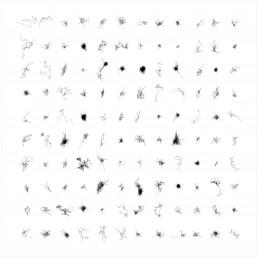
Glutamate Transporters
2019
archival pigment prints
editions of 5
An organized assemblage of facts is beautiful. Data in its raw and awesome power helps us interpret our world and experiences. Given X, Y, Z inputs, do human minds respond with predictable, albeit complex, thoughts and behaviors? Alternately, do we have the freedom to do otherwise and choose between multiple paths?
This topic is hotly debated as neuroscientists observe and study the molecular and electrical changes in the brain. One of these molecules is glutamate, which functions to identify the important signals from our sensory-laden environment. At scale, the microscopic movements of glutamate transporters appear random and chaotic, suggesting that our perceptions and behavior may be beyond our control.
Ashley N. Leek, PhD candidate in the Michael M. Tamkun lab, at Colorado State University, generously provided the GLT1 trajectory data for this series. Her work is supported by the National Institutes of Health Grant R01GM109888.









